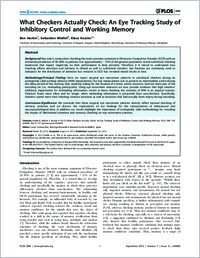What Checkers Actually Check: An Eye Tracking Study of Inhibitory Control and Working Memory
- Harkin, Ben Institute of Neuroscience and Psychology, University of Glasgow, Glasgow, United Kingdom
- Miellet, Sebastien Department of Psychology, University of Fribourg, Fribourg, Switzerland
- Kessler, Klaus Institute of Neuroscience and Psychology, University of Glasgow, Glasgow, United Kingdom
-
25.09.2012
Published in:
- PLoS ONE / Soriano-Mas, Carles ; Bellvitge Biomedical Research Institute-IDIBELL, Spain. - 2012, vol. 7, no. 9, p. 1-11
English
Background: Not only is compulsive checking the most common symptom in Obsessive Compulsive Disorder (OCD) with an estimated prevalence of 50–80% in patients, but approximately ,15% of the general population reveal subclinical checking tendencies that impact negatively on their performance in daily activities. Therefore, it is critical to understand how checking affects attention and memory in clinical as well as subclinical checkers. Eye fixations are commonly used as indicators for the distribution of attention but research in OCD has revealed mixed results at best. Methodology/Principal Finding: Here we report atypical eye movement patterns in subclinical checkers during an ecologically valid working memory (WM) manipulation. Our key manipulation was to present an intermediate probe during the delay period of the memory task, explicitly asking for the location of a letter, which, however, had not been part of the encoding set (i.e., misleading participants). Using eye movement measures we now provide evidence that high checkers’ inhibitory impairments for misleading information results in them checking the contents of WM in an atypical manner. Checkers fixate more often and for longer when misleading information is presented than non-checkers. Specifically, checkers spend more time checking stimulus locations as well as locations that had actually been empty during encoding. Conclusions/Significance: We conclude that these atypical eye movement patterns directly reflect internal checking of memory contents and we discuss the implications of our findings for the interpretation of behavioural and neuropsychological data. In addition our results highlight the importance of ecologically valid methodology for revealing the impact of detrimental attention and memory checking on eye movement patterns.
- Faculty
- Faculté des lettres et des sciences humaines
- Department
- Département de Psychologie
- Language
-
- English
- Classification
- Psychology
- License
-
License undefined
- Identifiers
-
- RERO DOC 30510
- DOI 10.1371/journal.pone.0044689
- Persistent URL
- https://folia.unifr.ch/unifr/documents/302533
Statistics
Document views: 109
File downloads:
- fichier principal: 146
